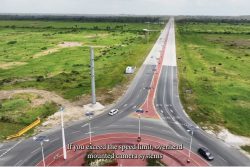Dear Editor,
I am glad that Rajendra Rampersaud (RR, 27 January) responded to my letter (25 January) because it gives me the opportunity to elaborate on issues raised therein. The Cambridge dictionary says that a contradiction occurs when “the fact of something being the complete opposite of something else or very different from something else, so that one of them must be wrong.” There are various kinds of contradictions but here we dwell on empirical contradictions. For example, it is a contradiction to say that the demand for FX in June 2023 was larger than supply but there was no shortage of FX. We now endeavor to find and understand the contradictions RR wrote about.
RR is right that the “economic activity of the oil company cannot be limited to” the less than 15 percent Guyana gets from oil revenue. That’s because linkages between the two economies have been growing, are significant, and contribute heavily to the non-oil economy growth. From 1960 to 2021, the non-oil economy grew by more than 10 percent only twice while it has been growing by more than that each year since 2022. I see no contradiction here: both RR and I agree that the oil economy has delivered a major growth boost to the non-oil economy.
Apparently, RR spies a contradiction is my statement that “export [of the non-oil economy] stagnated.” Exports by the non-oil economy increased from US$1.496 billion in 2019, the year before Guyana began to export crude oil, to a projected US$2.172 billion in 2025, which is an increase of 45.2 percent. While non-oil exports contracted in 2020 and 2021, stagnated in 2022, they grew each year thereafter, expanding by 16.0 percent in 2024. A direct result of a robustly growing non-oil economy is the surge of imports. Imports expanded from US$1.995 billion in 2019 to a projected US$9.012 billion in 2025, which is an increase of 351.7 percent. Given how the data are broken down, it is unknown if they include imports by both the oil and non-oil economy. However, it does not seem likely that imports by the oil economy are captured by the data: such imports are done directly by oil companies and mostly likely do not pass through local commercial banks. Otherwise, total imports by the overall economy should be much higher.
To reiterate, imports grew by 351.7 percent and exports by 45.2 percent from 2019 to 2025 (projected). That translates to an annual mean growth of 58.6 percent and 7.5 percent, respectively. It is in this sense – over a seven-year period – that non-oil exports basically stagnated. The vastly different performance between imports and export led to a huge and growing gap between them. Imports were 137. 7 percent of non-oil exports in 2013, fell to 133.4 percent in 2019, jumped to 150.5 percent in 2020, is expected to be 414.8 percent in 2025, an averaged 327.3 percent from 2020 to 2025. The growing gap between imports and non-oil export is a major reason for persistent FX shortages. Little, if any, of oil revenues flow into the FX market; Guyana’s share of less than 15 percent is deposited into the NRF. The vast growth disjunction (performance) between imports and exports can only be interpreted as relative stagnation of exports. Once again, I am unable to find any contradiction, but RR seems to have a shaper eye than I do.
RR spotted another non-existent contradiction: Gampat’s “arguments that BOG withdrawing more forex from the market than it injects is unsubstantiated. Last year the Bank sold more than 300 million forex to all commercial banks …” RR has greater access to data than I do; he knows the amount injected into the market for the entire of 2024. Why did he focus on a single year? That’s too short a period to capture the dynamics of a rapidly growing economy. Let’s see why. To begin with, the BoG Annual Report usually contains this sentence: “The exchange rate policy … was aimed at strengthening the macroeconomic conditions that facilitate price and balance of payments stability … The Bank may intervene to meet reserve targets …” (Annual Report 2023: 90). We now demonstrate that the BoG removed FX from the market both when there was a shortage and when there was not a shortage.
During the eleven years from 2013 to 2023, the BoG purchased US$712.5 million from the FX market and sold US$273.2 million. That’s a net withdrawal of US$273.2 million: the supply of FX contracted by that amount. Shortage of FX occurred four times, 2014, 2021, 2022 and 2023, and totaled, US$142.80 million while the BoG withdrew US$207.6 million. With the exception of 2014, it is the BoG, in pursuit of reserve targets and neglecting exchange rate stability, that caused the shortages. Is this a contradiction Mr. RR?
The year 2024 was different: there was a serious shortage of FX, and the Government instructed the Bank to inject greenbacks into the market, totaling US$212.75 million from January to September. That raises a fundamental question: if the major job of the BoG is price stability (exchange rate is a price), why did it not intervene into the market on its own accord? Is the BoG really an independent institution? Is it free to set monetary and exchange rate policies without the interference of the PPP Government? These data points bring an important issue to the fore: Guyana experienced a persistent and growing shortage of FX from 2021 to 2024, which was aggravated/ caused by the BoG. Will 2025 be the same? I think so for reasons explained in “The Guyanese FX Market.”
The fourth “contradiction” that RR points to is the share of TCGE to be spent on “Capital Expenditure” and “Other charges.” He writes: “a close reading of his published table shows the opposite with capital expenditure $737.68 billion and other charges being $416.57 billion.” RR is referring to dollar amounts while I spoke about “share” or percent; apparently he equated the two. In 2024, 58.1 percent of TCGE was channeled to “Capital Expenditure” compared to a 53.4 percent in 2025. That’s a shrinkage of 4.8 percentage points. On the other hand, 25.6 percent of TCGE was spent on “Other Charges” compared to 30.1 percent, which is an increase of 4.5 percentage points. There is no empirical or logical contradiction here.
The fifth “contradiction” RR discerns relates to the fiscal deficit. My argument is that the fiscal deficit should be gauged in relation to non-oil GDP and not total GDP. RR wrote: “the IMF considered a 15 percent deficit to non -oil GDP to be quite manageable and the same could argued on Guyana’s debt to GDP ratio that declined to 24.3 percent in 2024.” The literature is unanimous that a persistent fiscal deficit of over 6 percent or so can be a major cause of macroeconomic instability. I am baffled as to how this is a contradiction: what am I contradicting, Mr. RR? Please let us know which IMF publication states that a deficit of 15 percent of GDP is “manageable?”
Aside from non-existent contradictions to make lame arguments, RR veered into extraneous stuff: Guyana’s “vibrant manufacturing sector,” “untapped natural resources,” power supply, investment in health and education. These have nothing to do with what I wrote and, worst, they do not help RR to identify contradictions.
Summing up, RR resorted to beliefs, allegations, a single year (2024) to capture the dynamics of a rapidly enlarging economy, confused dollar amounts and percent of TCGE to show what he called “contradictions.” There are no contradictions in my 25 January letter and, based on the data in Budget 2025 and various BoG reports, I have shown that RR’s arguments are spurious. But perhaps the word “contradiction” has a new meaning of which I am not aware: puncturing propaganda, exposing lies and devious writing. Finally, oil export is projected to contract by 2.1 percent in 2025, which makes the sustainability issue even more alarming.
Yours sincerely,
Ramesh Gampat









